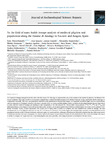Mostrar o rexistro simple do ítem
To the Field of Stars: Stable Isotope Analysis of Medieval Pilgrims and Populations Along the Camino de Santiago in Navarre and Aragon, Spain
| dc.contributor.author | Pérez-Ramallo, Patxi | |
| dc.contributor.author | Lorenzo Lizalde, José Ignacio | |
| dc.contributor.author | Staniewska, Alexandra | |
| dc.contributor.author | Aiestaran, Mattin | |
| dc.contributor.author | Aguirre, Juantxo | |
| dc.contributor.author | Sesma Sesma, Jesús | |
| dc.contributor.author | Marzo, Sara | |
| dc.contributor.author | Lucas, Mary | |
| dc.contributor.author | Ilgner, Jana | |
| dc.contributor.author | Chivall, David | |
| dc.contributor.author | Higham, Tom | |
| dc.contributor.author | Rodríguez-Varela, Ricardo | |
| dc.contributor.author | Götherström, Anders | |
| dc.contributor.author | Etxeberría Gabilondo, Francisco | |
| dc.contributor.author | Grandal-d'Anglade, Aurora | |
| dc.contributor.author | Alexander, Michelle | |
| dc.contributor.author | Roberts, Patrick | |
| dc.date.accessioned | 2023-05-26T19:13:41Z | |
| dc.date.available | 2023-05-26T19:13:41Z | |
| dc.date.issued | 2023-02-01 | |
| dc.identifier.citation | Patxi Pérez-Ramallo, José Ignacio Lorenzo-Lizalde, Alexandra Staniewska, Mattin Aiestaran, Juantxo Aguirre, Jesús Semas Sesma, Sara Marzo, Mary Lucas, Jana Ilgner, David Chivall, Tom Higham, Ricardo Rodríguez-Varela, Anders Götherström, Francisco Etxeberria, Aurora Grandal-d'Anglade, Michelle Alexander, Patrick Roberts, To the field of stars: Stable isotope analysis of medieval pilgrims and populations along the Camino de Santiago in Navarre and Aragon, Spain, Journal of Archaeological Science: Reports, Volume 48, 2023, 103847, ISSN 2352-409X, https://doi.org/10.1016/j.jasrep.2023.103847. (https://www.sciencedirect.com/science/article/pii/S2352409X23000226) | es_ES |
| dc.identifier.issn | 2352-409X | |
| dc.identifier.uri | http://hdl.handle.net/2183/33158 | |
| dc.description.abstract | [Abstract] The Camino de Santiago emerged in the first half of the 9th century CE following the reported discovery of the remains of the Apostle St James by the bishop of Iria-Flavia, Teodomiro. Since then, hundreds of thousands of pilgrims have walked from different parts of the Iberian Peninsula, Europe, and further afield to Santiago de Compostela's Cathedral. This route was particularly important to the populations of Navarre and Aragon, two kingdoms in northern Spain that rose to prominence with the resurgence of Christianity from the 11th century onwards. Here, we present multidisciplinary analysis of medieval individuals buried in Navarre and Aragon at a time when the Camino de Santiago was reaching its peak of popularity (11th-15th centuries CE). We use stable isotope analysis (δ15N, δ13C, δ18O, and δ13Cap) and radiocarbon dating to investigate a total of 82 human individuals together with 42 fauna samples from 8 different archaeological sites located in the northeast of the Iberian Peninsula. Twenty of these individuals were buried with a scallop shell, a symbol of a pilgrim who had completed the Camino de Santiago. Our data corroborate the use of the pilgrim's shell since at least the 11th century CE. Moreover, our results suggest that the pilgrimage was mainly an urban phenomenon for populations from the northern Iberian Peninsula, conducted equally by women and men, although with indications that female pilgrims may have had greater access to animal protein than their male counterparts. Our results represent the largest isotopic dataset of medieval individuals linked to the Camino de Santiago, allowing us to further investigate the origins and diets of potential pilgrims and, more generally, other sampled portions of northeastern Iberian society. | es_ES |
| dc.description.sponsorship | This project has been supported by a grant from the “la Caixa” Banking Foundation (ID 100010434), Code: LCF/BQ/ES16/11570006; and funded by the European Union-Next Generation EU, Margarita Salas Fellowship, Ministerio de Universidades, UPV/EHU. Patxi Pérez-Ramallo and Patrick Roberts would also like to thank the Max Planck Society for funding for this project. The authors extend their special gratitude to the Oxford Radiocarbon Accelerator Unit (ORAU), University of Oxford, the Heritage and Government of Navarre, the Aranzadi Society of Science, the Museo de Huesca, the heritage of the Government of Aragón, Julia Justes and Belén Gimeno. Michelle Alexander’s analysis at Durham was supported by an AHRC studentship Ref: 2006/125150/University of Durham under the name of Mundee | es_ES |
| dc.description.sponsorship | Fundación “la Caixa”; LCF/BQ/ES16/11570006 | es_ES |
| dc.description.sponsorship | University of Durham; 2006/125150 | es_ES |
| dc.language.iso | eng | es_ES |
| dc.publisher | Elsevier | es_ES |
| dc.relation.uri | https://doi.org/10.1016/j.jasrep.2023.103847 | es_ES |
| dc.rights | Atribución 4.0 Internacional | es_ES |
| dc.rights.uri | http://creativecommons.org/licenses/by/4.0/ | * |
| dc.subject | Radiocarbon dating | es_ES |
| dc.subject | Medieval pilgrimage | es_ES |
| dc.subject | Camino de Santiago | es_ES |
| dc.subject | Northern Iberian Peninsula | es_ES |
| dc.subject | Population | es_ES |
| dc.title | To the Field of Stars: Stable Isotope Analysis of Medieval Pilgrims and Populations Along the Camino de Santiago in Navarre and Aragon, Spain | es_ES |
| dc.type | info:eu-repo/semantics/article | es_ES |
| dc.rights.access | info:eu-repo/semantics/openAccess | es_ES |
| UDC.journalTitle | Journal of Archaeological Science: Reports | es_ES |
| UDC.volume | 48 | es_ES |
| UDC.issue | April 2023 | es_ES |
| UDC.startPage | 103847 | es_ES |
| dc.identifier.doi | 10.1016/j.jasrep.2023.103847 |
Ficheiros no ítem
Este ítem aparece na(s) seguinte(s) colección(s)
-
IUX-CULXEO - Artigos [64]







